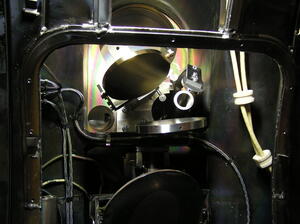Tracking the fast ion
The in-vessel components of a new diagnostic will be included in the ITER Baseline design to measure fast ions—elusive particles that are a natural consequence of the fusion process and plasma heating techniques, and which carry energies some two orders of magnitude higher than the 'bulk' ions and electrons in the plasma.
This follows an independent review of the ITER diagnostic systems, during which experts concluded that the capability to measure fast ions—hydrogen, deuterium, tritium, and alpha particles—should be enhanced. These in-vessel components will enable a cost-effective installation of the complete diagnostic system later during the operational program.
Although they represent less than 5 percent of plasma density, fast ions carry up to one-third of the plasma's kinetic energy. Colliding with and transferring their energy to the "bulk" particles in the plasma, fast ions contribute to sustaining the high plasma temperatures required for the fusion reaction. Optimizing their confinement within the plasma is important for fusion performance. Energetic particle populations of the type expected in ITER are not without problems, however. Fast ions behave unpredictably; while some remain within the magnetic field, others escape the plasma and reduce confinement, or "cause mischief" by contributing their energy to and amplifying plasma disturbances.
Collective Thomson Scattering (CTS), currently being exploited on two European fusion devices by the Risoe DTU National Laboratory for Sustainable Energy in Denmark in conjunction with Dutch and German laboratories, will be able to provide important data on the dynamics of fast ions, helping scientists to understand and predict their behaviour. Other fusion devices in Italy (FTU) and Japan (LHD) have also adopted CTS for fast ion measurements.
Confined fast ions have eluded experimental observation within plasmas in the past. Traditional laser diagnostic techniques that measure plasma densities and temperatures interact more easily with the lighter electrons than the heavier ions—effectively detecting only the electrons. CTS adopts a different approach. "It is a bit like a camera zooming out," explains Soeren Korsholm, senior scientist at the Risoe National Laboratory in Roskilde, Denmark. "Instead of focusing on an individual particle, we look instead at the collective motion of the whole group."
CTS exploits the fact that ions leave a wake as they travel through a cloud of electrons, like a swan as it moves across a lake. Although the ions may be next to impossible to "see," their wakes can be detected by the CTS technique. At a certain scale (much larger than electrons) ion wakes are the dominant cause of microscopic fluctuations in the plasma.
CTS sends an intense one-megawatt electromagnetic beam deep into the plasma, equivalent to 1,000 microwave ovens at full power. As the beam interacts with collective electron fluctuations, waves are scattered in all directions. Diagnostic mirrors tuned to the beam detect this scattered light, and transmit signals that are converted into frequencies that can be interpreted by computer. CTS receivers are so sensitive that they are able to discriminate scattered signals that are 12-15 orders of magnitude smaller than the injected beam power. Through extensive computer analysis and "a solid understanding of the physics' mechanisms involved," scientists are able to deduce information about the velocity and the distribution of fast ions in the plasma.
The conceptual CTS design that is foreseen for ITER was undertaken by the group at Risoe, under contract from the European Fusion Development Agreement (EFDA). Currently, work is ongoing to perfect the CTS technique through experiments at ASDEX Upgrade and TEXTOR in Germany—two tokamaks with gyrotron capabilities sufficient to producing the powerful beam necessary. CTS technology continues to evolve. Although technically demanding, CTS can provide important information on fast ions and their behavior, and may eventually be able to measure more plasma parameters.
Story developed in conjunction with Soeren Korsholm, Senior Scientist at the Risoe National Laboratory for Sustainable Energy in Roskilde, Denmark.



